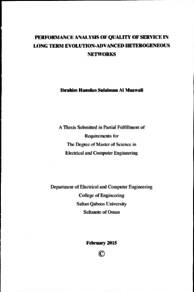Document
Performance analysis of quality of service in long term evolution-advanced hertrogeneous networks
Publisher
Sultan Qaboos University
Gregorian
2015
Language
English
English abstract
Mobile data traffic demand is continuously increasing as smart mobile phones, Over The Top (OTT) applications and social media are the main reasons behind this increase. Telecommunications operators have to satisfy subscribers' demands. The traditional mobile networks, known as homogenous networks, have become unable to satisfy the huge demand of data although the launch of 4G, LTEAdvanced solution appears to be too costly, as it is difficult to find places for more site acquisition especially in dense areas. Consequently, heterogeneous network (HetNet) is a key alternative solution to increasing the spectral efficiency and hence, it will be able to fulfill the data traffic demand. Long Term EvolutionAdvanced (LTE-A) HetNet consists basically of planned placement of base stations, called eNodeB, that typically transmit at high power levels overlaid with several small cells such as picocells and femtocells that transmit at low power levels.
However, the difference in the transmitted power between the macrocells and small cells are too high. As a result, the interference between different cells becomes high as well. This might lead to a degradation of the whole network performance, and hence to the decrease in the Quality of Service (QoS). The main objective is to analyze LTE-A Heterogeneous Network and propose a model accordingly.
In this study, an investigation of Range Cell Expansion (RCE) is conducted. The RCE is used to overcome the coverage problems which are due to the difference in transmitted power between cells so that the UE can connect to the cells with a weaker Reference Signal Received Power (RSRP). The RCE adds an offset value to the RSRP of the pico eNodeB, and hence the UE preferentially selects the picocell as its serving cell although it is not the strongest RSRP cell. However, the value of the offset has to be determined carefully to achieve better performance.
This technique might lead to more generation of additional interference between the cells, and therefore interference coordination is required to protect offloaded UEs in the expanded region. The Enhanced Inter-cell Interference Coordination (eICIC) is proposed in this study to mitigate the generated interference among the cells.
There are two major categories of eICIC: time-domain resource partitioning and frequency domain resource partitioning. In this study, an investigation of the time domain resource partitioning is conducted where the main considered idea here is to prevent the macro base stations from transmitting on particular subframes, and thus reduces the interference to the neighbors' base stations, called eNodeB. These subframes are called Almost Blank Subframes (ABS).
ABS ratio is considered as a key parameter to identify network performance such as the outage probability and the average data rate. Hence, a cell selection scheme is proposed in this study based on the outage probability of the target cell using
The method used to model and analyze the SINR was based on stochastic geometry scheme. This is done by modeling the locations of the base station by a certain distributed point process called Poisson Point process and some QoS parameters have derived accordingly such as outage probability and average data rate.
Finally, the general obtained mathematical expressions have been assessed using numerical computation. This has been carried out by means of Matlab simulation for different scenarios and the analysis of results. Network performance has been determined in terms of QoS parameters such as the outage probability and average data rate in terms of ABS ratio, bias value and picocell density. It is clear from the obtained results that the telecom operators have to select carefully the required parameters, such as bias value, ABS ratio and picocell density, to get a better QoS network performance.
Description
Thesis
Member of
Resource URL
Arabic abstract
تشير التقارير العالمية إلى ارتفاع هائل وملحوظ في الطلب على البيانات من خلال الشبكات الخلوية، حيث تعزي عوامل تلك الزيادة الى انتشار الهواتف الذكية وزيادة التطبيقات مع زيادة ملحوظة في أعداد المستخدمين للهواتف النقالة. وعلى الرغم من التطور الملحوظ في تقنية الجيل الرابع، والتي تم إطلاقها عام 2009، من حيث القدرة على استيعاب أعداد أكبر من المستخدمين في آن واحد ، وكذلك معدل نقل البيانات المطلوبة للمستخدم، والتي أدت إلى تفاؤل من قبل مشغلي شبكات الاتصالات إلا أن ذلك التفاؤل ما لبث أن تهادى ، لتظل مشكلة الطلب على تلك البيانات تزداد بشكل كبير جدا.تشكل الشبكات الغير متجانسة المفتاح لحل تلك المشكلة، حيث أن كفاءة الشبكة تزداد من خلال التوازن بين جميع خلايا المحطات المختلفة بحيث ترتبط أجهزة الهواتف النقالة بتلك الخلايا بشكل متوازن ، وينتقل الضغط من خلايا المحطات ذات الطاقة الكبيرة الى جميع المحطات، وذلك بحسب مقدرة المحطة.وحتى يتم ذلك بشكل عملي ومجدي، لا بد من التوافق بين خلايا تلك المحطات من حيثطاقة الإشارة المستقبلة. ويتم ذلك بإضافة رقم تعويضي للخلايا ذات الطاقة البسيطة. علما بأن ذلك قد يؤدي إلى زيادة التداخل الضوضائي بين مختلف الخلايا. حينها لا بد من التنسيق للتخفيف من تلك التداخلات.لذا بنيت هذه الدراسة على التحقيق في الشبكات الغير المتجانسة بنظام التطور الطويل الأمد المتقدم من حيث التوازن بين جميع خلايا المحطات، والتنسيق للتخفيف من حدة التداخلات الناجمة عن ذلك. وتقوم هذه الدراسة باقتراح آلية لاختيار الخلية الملائمة للاتصال بها من قبل الهاتف المتنقلب بالإعتماد على ما ورد أعلاه، وكذلك التأكد من جدوى تلك الآلية على جودة الخدمة من خلال عمل محاكاة باستخدام بيانات مماثلة للواقع، وتحليل النتائج بحيث تتواكب مع الأهداف من هذه الدراسة
Category
Theses and Dissertations

